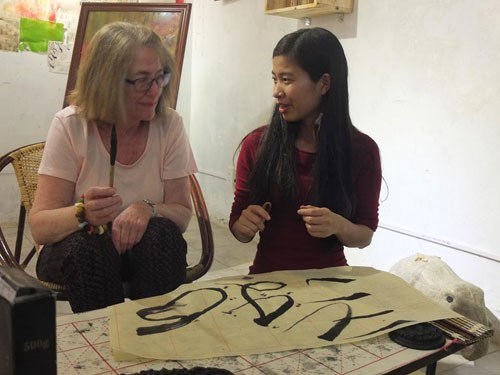In a small rural village 45 kilometers southwest of Hanoi, lies Suoi Co where the ancient art of Do paper-making is being kept alive. Do is a type of paper that was traditionally made in Vietnamese villages that was popular with folk art due to its durability.

Produced from the bark of Rhamnoneuron Balansae, a highly cellulose tree found in Northern Vietnam and China’s Yunnan Province, Do paper-making needs abundant water, space and time. Traditionally, the tree bark would soak in limewater for about three months until it was soft enough separate from the pulp – though today, papermakers have managed to shorten this phase to just 24 hours. The pulp is then pounded flat and smooth, and layered to form sheets of paper that are dried naturally in the sun for weeks. The result is beautifully soft, rustic paper that does not smudge ink, is highly resistant to humidity and acid-free, attracts fewer termites, and most surprisingly, can last for centuries.

Tran Hong Nhung , a young entrepreneur from Hanoi, founder of social enterprise ‘Zo Project’ aims to help modernize this dying art.

Dating back to the 13th Century, Do was largely used in Vietnam as a canvas for folk artwork, but due to the country’s industrialization, it was becoming obsolete in favor of more modern, accessible alternatives. By producing product from notebooks to several different types of rough, robust paper that artists can use as canvases, Zo Project helps support the livelihood of impoverished villagers and preserves art form that has been forgotten by time.
During a visit to Duong O, the village where the art originated, about 40km northeast of Hanoi in the Red River Delta, she found out that only three families remain keeping up the traditional paper-making tradition alive.
From our partners:
“I struggled to convince the villagers the tradition was worth saving.”

I struggled to convince [the villagers] the tradition was worth saving, especially because nobody from the younger generations was interested in keeping up the hard work,” she explained. “The whole village had already transformed into a small town surrounded by factories. The space needed to produce handmade paper was no longer available, and on top of that, the water sources were completely polluted.”
“Vietnam is different. We don’t get any help from the central government here.”
The Zo Project had a rough start with the remaining paper makers, encountering constant hurdles. Help came in the form of the JICA Foundation, which had worked with Duong O villagers before. They sought the help of a Japanese expert to help the villagers learn how to make handmade paper.
“I admire the way Japan transformed their Washi paper-making into a Unesco intangible cultural heritage, making it a desirable form of art in their society,” Nhung said. “But Vietnam is different. We don’t get any help from the central government here.”

With this newly acquired skill and with all the necessary resources and space at hand, the Duong O villagers are starting to turn their situation around. Nhung plans to open the Do workshop to the public as soon as the funds allow. This will help garner more attention from foreigners who are interested in the Do paper-making as well as receive lessons and painting and experience the work involved.
Nhung has travelled all over Southeast Asia to promote the rebirth of Do and learn new techniques on handmade paper-making. Do is now being distributed by art suppliers around the world, as well as made into notebooks, postcards and other paper gifts that Nhung sells from her Zo Souvenir Shop, a boutique in Ba Dinh, Hanoi’s railway district. All of the profits made goes back into financing the project.
“At the moment, there are efforts to lobby social enterprise development in Vietnam, but I think there’s still a long way to go,” Nhung said.
This feature’s source came from BBC.

















